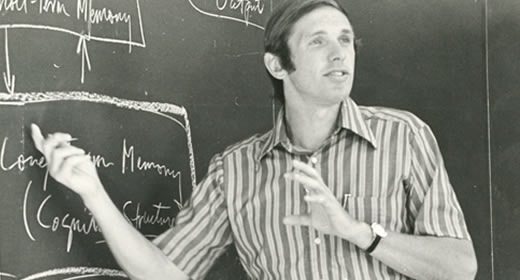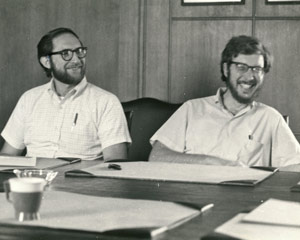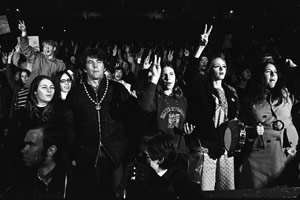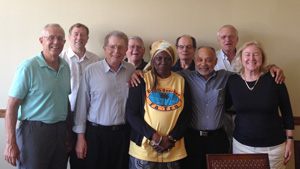
The protests started in earnest in the spring of 1965.
Operation “Rolling Thunder,” spearheaded by Defense Secretary Robert McNamara, commenced on March 2, with massive and near-continuous air strikes of Vietnam. The first U.S. combat troops were sent the following week, and napalm, a flammable gel responsible for deadly and debilitating burns, would soon follow.
By the end of March, U-M students and faculty would organize the nation’s first teach-in to protest the war. More than 3,000 U-M students and 200 faculty members would attend.
By May, teach-ins had spread to college campuses across America and U-M students were gearing up for new protests. They’d rail against the draft, against defense research, against racial discrimination, against drug laws, against pollution, and more.
Rick Curtis (BGS ’70, MPP ’72), who worked in the residence halls from 1968 to 1972, says incoming freshmen didn’t ask about the first football game, or the first college party. They asked about the first student protest.
Emery “Ozzie” Roe (BA ’70, MPP ’72) remembers the internal fervor of the ’60s, too. “We were trying to understand not just social issues, but existential ones. How does this bigger world affect you and where are you in it? How can you be white and not politically active and still be a human being?”
 |
Roger Short (BA ’70, MPP ’72) remembers working with the Black Student Union to recruit more black students and faculty, and participating in the Black Action Movement’s (BAM) week-long strike when administrators disregarded their demands. Short says he wasn’t a revolutionary, but wanted to be sure U-M would be responsive to the needs and concerns of black students.
“There was an interest in violent confrontation with what they called ‘the establishment.’ There was unrest and anger. The radical left was interested in harnessing and furthering that,” says Rick Curtis of the times. During an undergraduate class discussion, Curtis remembers hearing a student say it would be great if someone were killed in a protest, because they’d become a martyr and their death would inspire others.
“There had been bombings of buildings, violent confrontations with police,” he says. “It felt like things would spin out of control, as they had at other places….My friends and I were afraid of the rigid ideologies and the fervor—of the far left and of the far right,” says Curtis. “For those of us who valued human life, and valued some degree of moderation and considered judgment, it was horrifying.”
Curtis helped to found Students for Effective Action, an organization dedicated to peaceful, democratic change. Thomas Linn (BA ’70, MPP ’72, JD ’76) became an expert on Selective Service deferments, and counseled U-M students about how to avoid the draft.
There were dozens of loopholes, and Linn knew students who took advantage of all of them. There were students who married, or became conscientious objectors, or received a medical exclusion. There was someone who cut off a toe, someone who lost weight, someone who gained it.
Roe remembers a life-changing undergraduate course he took with John Patrick (Pat) Crecine, who had been tapped to serve as founding director of the Institute of Public Policy Studies (the Ford School) in 1968.
Crecine would invite guest lecturers and policy leaders—including John Steinbruner and Graham Allison—to talk about war and decision-making under pressure. They would talk about the threat of nuclear war. About the Cuban Missile Crisis. About the cybernetic theory of decision-making. “It was transformative,” says Roe.
It was Crecine who convinced Roe, and many others, to study policy as the nascent program was launched in the fall of 1969.
1969, the dawn of public policy
Pat Crecine was just 28, an untenured assistant professor (about to be promoted) returning from a year-long stint at the pioneering RAND Corporation, when U-M administrators put him in charge of the new Institute of Public Policy Studies (IPPS).
Accounts vary. He was magnetic. Dynamic. Effective. Handsome. He was a mumbler. A terrible teacher. A wonderful mentor. He was critical. Empowering. Personable. Intense. Low key. He was dashing. Brilliant. A visionary in the field. A change-agent. A marvelous organizational leader. Politically astute. A remarkable man.
Crecine wasn’t a radical. He wasn’t an activist. He loved sailing, and football, and athletics. He had a kegerator, and often invited his graduate students over for drinks. But Crecine was someone who cared deeply about social challenges, and he was in the vanguard of an intellectual revolution.
For more than 50 years, the Institute had focused its curriculum on public administration, offering aspiring public servants training in management, budgeting, human resources, and related skills.
But while U-M’s public administration program and alumni had been immensely successful, some University faculty and administrators felt public servants required additional skills to address the complex national and global challenges that were coming to light in the late 1960s.
In time, it would become clear that administration, activism, law, and policy all played a role in affecting change, but in 1969, when the first students enrolled in Crecine’s just launched degree program, policy analysis was novel.
The still-evolving curriculum combined disciplinary training in political science, economics, statistics, and organizational theory. Early faculty included the political scientists Joel Aberbach, Ron Brunner, Larry Mohr (MPA ’63, PhD ’66), Robert Putnam, and Jack Walker; the economists Mike Scherer and Sid Winter; Stephen Pollock, who taught operations research; and John Chamberlin, who taught a new core course in statistics.
"The core curriculum was designed to give students solid foundations in the social and management sciences, providing analytical frameworks that graduates could apply to a broad array of policy problems throughout their careers," says Chamberlin.
But while the program was quantitative and rigorous, it was also applied. There were computer simulations, applied policy projects, case studies, and internships.
Ann Branston (MPP ’71) remembers interning during the school year with Don Borut (MPA ’65), then assistant city manager of Ann Arbor, and in the summer with the U.S. Office of Economic Opportunity in Washington, DC.
And there was a feeling that with these powerful tools and techniques, students and faculty might help to untangle some of the complex issues of the era—poverty, racial discrimination, environmental degradation, and escalating military conflicts.
John Chamberlin (who was then finishing his PhD at Stanford Business School) says the complex challenges of the mid- to late-‘60s, and the exciting new discipline, drove him to choose policy over business.
A handful of leading universities were starting, or hoping to start, public policy programs, he says. The University of Michigan was among the very first to do so.
Faculty reflections
Larry Mohr, who had earned his master’s of public administration (at the Institute) in 1963 and his PhD in political science at U-M in 1966, joined his alma mater as an assistant professor of political science in the fall of 1966. He recalls the demonstrations, the protests, and the radical students who were “objecting to everything, all of the time.”
“Most of the faculty at Michigan felt these were topics they ought to pay attention to,” he says. Student protests brought attention to serious social concerns, some of which would become the focus of game-changing scholarly research for the Institute's faculty. But at the time of the protests, he says, the focus at IPPS was on the evolving curriculum, preparing students for leadership, and the growing faculty research program.
“[Crecine] ran the Institute as an intellectual institution,” says Mohr. He complemented working papers with “smirking papers” and organized “half-baked idea” seminars (later called “brown bag” seminars). The goal: to encourage faculty to share their research at early stages of development when ideas were still fresh and malleable.
Mohr recalls one of his own seminars on “Resisting the urge to run a partial correlation.” At the time, he says, computers didn’t do it for you. “You had to multiply out pairs of numbers and add up the products of a long list; you’d forget where you were and have to start all over again. It was a chore, not a nanosecond, as it is now with a computer.” But the idea of the talk, he says, was that you didn’t get as much out of [a partial correlation] as you’d think.
Other early half-baked idea seminars included “A model of dynamic competition,” (Sid Winter); “Aspects of racial segregation in housing markets,” (Paul Courant); “The diffusion of knowledge and policy change,” (Jack Walker); “The logic of collective action,” (John Chamberlin); “What to expect when the reds rule Rome,” (Bob Putnam); and more.
"The half-baked idea seminars were incredibly interesting and important," says Bob Putnam, who remembers the era's energy and faculty. "You could try out an idea...and everybody was there, so [the political scientists] would hear what the economists thought about our work and the kinds of questions they would ask about the problems that we were worried about."
Ultimately, the transformation at IPPS was intellectual, not political, says Mohr. “It was motivating people, and that’s what we talked about.”
 |
Joel Aberbach, who joined the faculty in 1967, says “there had been this general upheaval, and expectations were exceedingly high about how the world was going to change--and in many ways, it did.”
For U-M undergraduates, Aberbach taught a course on “The politics of disaffection,” which focused on racism, drug laws, and the war. For IPPSters, he designed a brand new course on “The political environment of public policy,” (PubPol 585, still taught today) which he co-taught with Jack Walker.
Aberbach and Walker collaborated on other work, as well, including Race in the City, a book that grew out of research they conducted in the wake of Detroit’s 1967 riot.
“There was a notion—simultaneously, with all the radicalism—that there were technical solutions to major problems and that by use of good analysis you could figure out how to solve society’s problems and design programs that would be effective to do that,” says Aberbach. “I think we had the sense that we were in the vanguard.”
Alumni reflections, the curriculum
“The curriculum was innovative for its time—very project-oriented, with students working in groups,” says alumnus Patrick Keating (MPP ’74), who went on to earn a PhD in higher education administration.
Keating remembers being given a policy problem and some background data, and having to work with his classmates to develop a two-page memo with background and recommendations—all within three hours. “At the time, I thought it was strange,” he says. “But looking back, I realize that was real life; you have limited time, limited information, and you have to do the best job you can.”
Jim Hudak (MPP ’71) remembers the case studies. Faculty would have students study real-world problems, and would bring in outside experts to introduce them to the issues and listen to their analyses. For one course, Hudak recalls exploring the feasibility of anti-ballistic missile centers for the Department of Defense; for another course, it was analyzing the costs and benefits of a new shopping center for the City of Ann Arbor.
There was an “excitement that came from actually thinking that there could be a toolkit, a set of optics,” for studying the world, says Emery Roe of the curriculum. The policy toolkit wasn’t a way of simplifying social problems, he says, it was a way of thinking about them differently. “[Crecine] was always talking about complex issues that didn’t have simple statistical, political, or legal solutions—problems that needed a combined approach.”
Ann Branston, who had earned her BA in political science, recalls being challenged by the intense quantitative focus at the start of her studies. “When I applied, I didn’t entirely understand the difference [between a master’s in public administration and a master’s in public policy],” she says.
 |
Though Branston was initially frustrated that there wasn’t much focus on management—“at the time,” she says, “they were so focused on getting away from administration”—she believes the program gave her something equally important, “an appreciation of the analytical complexity of policy issues.”
Of course, faculty talked about the limitations of quantitative analysis, as well.
“Crecine’s class really got us thinking about the war,” says Vic Miller (MPP ’72), who was then a young Vietnam-era veteran attracted to the idea of serving his country as a civilian, rather than a soldier. “[Robert] McNamara was this incredibly rationalistic person who said we can add and subtract and get to the right answer, and he turned out to be wrong.”
At work in the world
With the new curriculum in place, the Institute graduated 18 alumni in 1971. The 10 who completed their degree requirements in time for spring graduation may be the first in history to earn master’s degrees in public policy.
In keeping with the program’s increasingly interdisciplinary vision, those alumni held undergraduate degrees in a range of fields, including sociology, economics, engineering, business, government, philosophy, political science, and other disciplines. Among the first to answer the question, “What does one do with a public policy degree?” 1971 graduates—more than one-quarter of them women; one in six of them black—went on to lead equally diverse and influential careers.
Sherry Suttles (MPP ‘71) would go on to become the first black woman to serve as a city manager in the United States. Suttles had grown up in Detroit, Mich., had studied government at Barnard College, and had been active in the civil rights movement. At the age of 31, she took her first city manager position in Oberlin, Ohio.
Ann Branston would embark on a career in transit for the Bay Area Rapid Transit (BART) system. At the age of 34, she was deputy general manager of maintenance, overseeing 800 mechanics. During her 16 years with BART, she led performance monitoring, strategic planning, budgeting, and more.
George R. Kolb (MPA ’71) would spend more than four decades in municipal administration, serving as chief administrator of cities ranging in size from 7,500 to 385,000. Patrick D. Larkey (MPP ’71, PhD ’75) would become a professor, and would lead the Department of Social and Decision Sciences at Carnegie-Mellon University. And Jim Hudak would become a nationally recognized leader in the healthcare industry.
Alumni of the classes of 1972, ’73, and ’74 enjoyed similarly diverse careers.
One managed rural and agricultural development projects in Africa. Another helped post-conflict and transitioning countries restructure their finances. A third worked in natural resource management in the U.S. and abroad. A fourth helped to found a not-for-profit that played an active role in the development of the Affordable Care Act. A fifth became executive vice president of a major university. A sixth helped hundreds of commercial and public borrowers finance large and small development projects in Detroit. A seventh helped Detroit’s Emergency Financial Manager with the city's bankruptcy proceedings.
Municipal administration. Public transit. Health policy. International development. Budgeting. National resource management. Higher education. Economic development. And more. The public policy degree provided versatile training that could be applied to dozens of challenges at local, state, national, and international levels.
Looking back
 |
“We weren’t radicals,” Jim Hudak recalls of his classmates and fellow alumni. “We believed that government was essentially good and we felt that to make things better, the way to do it was to learn, to get a job in government, and to make smart and sensitive choices.”
The Institute’s faculty members seemed to appreciate that dedication, and appreciate their students, as well.
Thomas Linn recalls the closeness between students and faculty at the time. Most of the graduate students were in their early 20s; most of the faculty weren’t much older. Linn recalls helping John Chamberlin build a kiln in his back yard; Chamberlin helped him build a potter’s wheel.
“We were these geeky, serious people,” says Hudak. “We worked hard, and we learned a lot, but it was a good time, there was a fabulous camaraderie.”
Now co-chair of the Ford School Committee, Hudak continues to recommend the program to those interested in public and private sector careers alike. “From my view, for me personally, it set up my whole life,” he says.
Joel Aberbach, who taught in the program both before and after its transition, says the remarkable thing was that the University of Michigan was willing to gamble both on a young administrator like Pat, and an emerging discipline like public policy.
“It could have sunk, it could have been a disaster,” he says.
“At a traditional institution, with ranks and hierarchy, it was a pretty audacious move. But they judged Pat as having a set of interesting and important ideas, and they put the resources behind him, and they were right.”
Graduates of the classes of ‘71, ‘72, and ‘73, share your reflections about early IPPS (email [email protected]) and we’ll add them to the story. And if you have photos, please send them along. We'd love to add them to the IPPStory, and to our archives.
IPPSter reflections
Harv Schubothe (MPP ’72).
I too was very much opposed to the war, but unlike many of my classmates I had tried to work from within. After two futile years of producing models and analyses that demonstrated the inevitable and eventual outcome, I concluded that it was time to apply my analytical background in a more useful and productive way. The U of M’s leadership in student protests and the new IPPS program focus on bringing quantitative problem solving into the public sector made the decision on where to turn to next an easy one.
It led to a lifelong relationship with Pat Crecine. It started with house sitting for the Crecines. That did not mean being the guardian of the kegerator but rather the dog-sitter for Teddy, their gigantic Saint Bernard. I mean, Teddy was huge, famous for running over a Volkswagen at one of our touch football games.
Pat’s strongest athletic skill came as a fast-pitch softball pitcher. I was Pat’s catcher, the only place to see any action on the field as Pat’s pitches were virtually unhittable. My job was to play catch and throw out the one or two baserunners who managed to reach a base safely against him each game.
Pat and I remained in touch after leaving the U of M, primarily through the oldest fantasy sports game in the country where we were two of twenty five participants. Pat and I shared a passion for modeling and computer simulation, believing there was almost nothing that we could not build a forecast for. I have continued with the National Baseball Seminar since Pat has passed and Ren Farley has also continued to participate.
The skills developed and lessons learned at IPPS have proven invaluable for me. Like Ann Branston, I interned with Don Borut. Upon graduating, I embarked on a 30 year career as an administrator in State agencies in Oregon. I retired from the public sector only to jump into administration of non-profit organizations where I still serve as president of five different board of directors.
